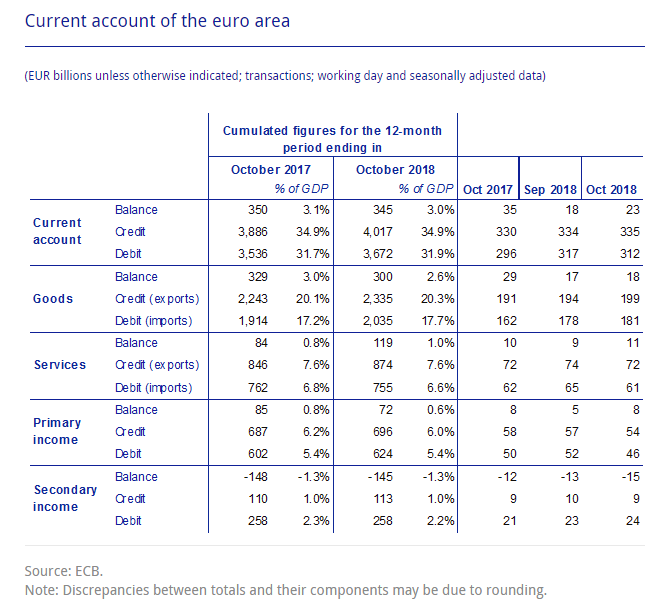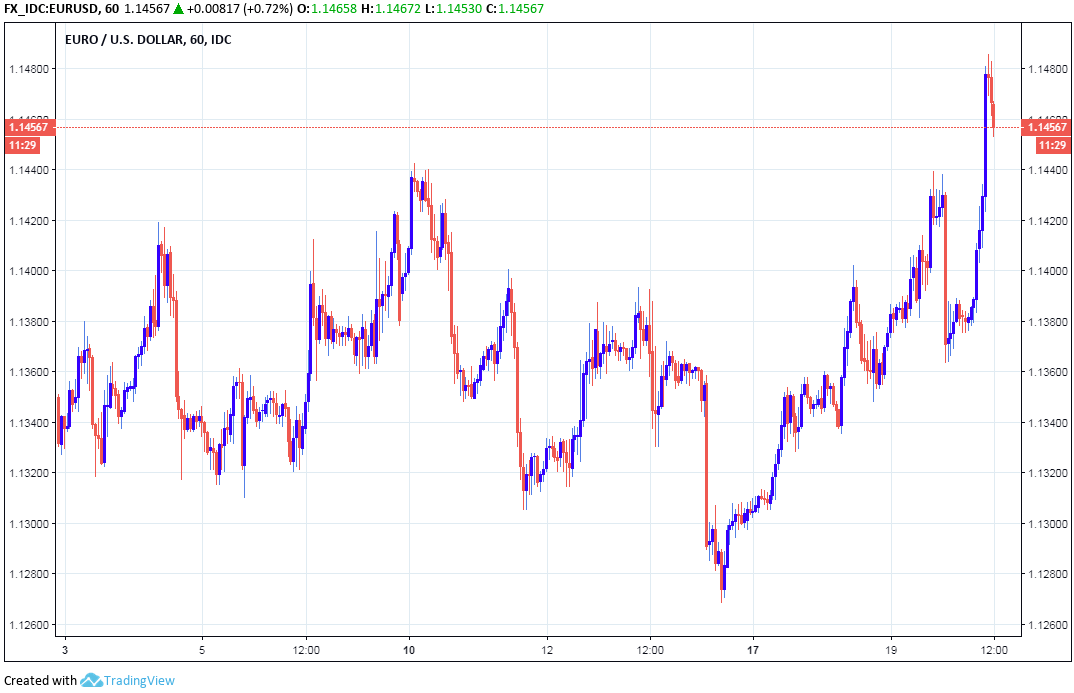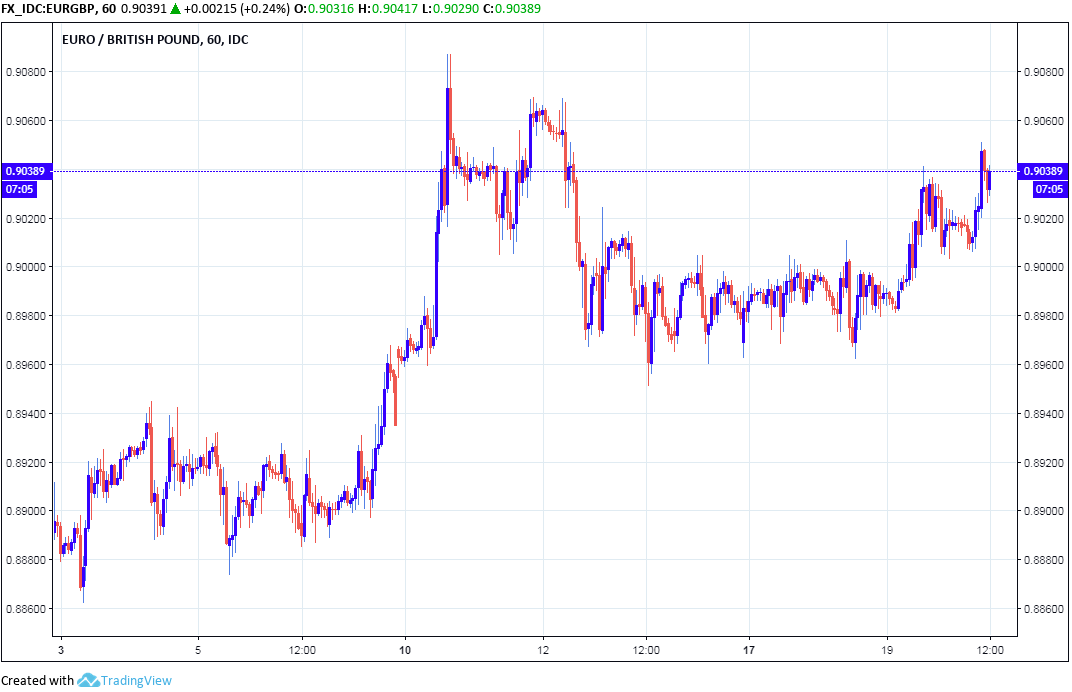Euro Outlook has Brightened as Currency Bloc's Stars Align for a Recovery
- Written by: James Skinner
-

© European Central Bank
- EURUSD lifts as economic and political stars align for a recovery.
- Capital flows, Fed policy retreat and Italian detente all positive for EUR.
- But sustainable recovery requires progress toward ECB targets in 2019.
The Euro rose sharply Thursday after current account data for October provided the single currency further tailwind of support, which comes on top of relief over a detente between the Italian government and European Commission.
Appetite for the currency is also improving as the U.S. Dollar retreats further from 18-month highs wracked up earlier in the week, which is the result of a landmark shift in Federal Reserve (Fed) interest rate policy.
The Eurozone current account surplus rose much more sharply than was expected for October, according to Eurostat data published Thursday.
October's surplus was €23 billion, up from €18 billion in September and ahead of the market consensus for an €18.4 billion reading, which saw the annual surplus come in at €345 billion for the year to the end of October.
Although down from €350 billion in the prior year, this still leaves the Eurozone with a surplus equal to 3% of overall GDP, which is a mere 10 basis points below that seen in 2017.

Above: Eurozone current account balance and components.
Current accounts measure changes in the amount of money flowing into and out of an economy as well as movements in borrowing from the rest of the world.
Markets care about the data because it paints a telling picture of international demand a currency and provides insight into the extent to which a nation is exposed to the changing sentiments of investors.
The Eurozone's latest surplus was the result of the bloc's combined goods and services trade balance holding up better than was expected during the year to the end of October.
Capital outflows from the Eurozone also slowed during the period, which offset much of a decline in capital inflows from overseas during a year when the continent has once again been rocked by political instability.

Above: Euro-to-Dollar rate shown at hourly intervals.
The Euro-to-Dollar rate was quoted 0.72% higher at 1.1468 Thursday and is now down just -4.37% for 2018, while the Euro-to-Pound rate was up 2.17% for the year when quoted at 0.9039 at noon, 0.24% higher for the session.

Above: Euro-to-Pound rate shown at hourly intervals.
Euro price action comes amid heavy losses for the Dollar, which traders have dumped by the bucket-load since the Fed's December policy statement.
The U.S. central bank sounded the alarm Wednesday over the impact a global slowdown and financial market volatility may soon have on the U.S. economy.
It still raised U.S. rates for a fourth time this year, taking the top end of the Federal funds range to 2.5%, but it also hinted strongly that rates will not rise nearly as fast next year as they have done so far.
While $EUR's rallying on its own accord (dovish Fed + rebound in Eurozone current account data)... have the Riksbank paved the way for the ECB to normalise? Synchronised DM Europe monetary tightening would mitigate -ve trade effects (via FX). Long European FX vs. $USD in 2019... pic.twitter.com/BpGEBn3hxr
— Viraj Patel (@VPatelFX) December 20, 2018
Markets had suspected such a move was in the cards but that hasn't taken the sting out of it for the Dollar. The Fed's u-turn is effectively an acknowledgement that the days of U.S. economic exceptionalism are now over.
But exceptionalism was exactly what enabled the greenback to turn the tables on the Euro this year, with superior growth allowing the Fed to keep raising its interest rate just as the European Central Bank (ECB) outlook turned sour.
That interest rate divergence drove the gap or spread between short-term European and U.S. government bond yields further in favour of the Dollar, deterring capital flows away from the bloc and its currency.

Above: EUR/USD (red & blue) alongside 2-year German-U.S. bond yield spread (orange).
Thursday's price action also comes after Italy's government reached an agreement with the European Commission, under which its budget deficit for 2019 will come in at levels more acceptable to EU officials.
Italy's budget deficit is now projected by the Commission to come in at 2.04% of GDP for 2019. Under Italy's earlier plan the budget deficit was expected to rise from a projected 1.8% of GDP for 2018 to 2.4% for 2019.
However, the European Commission now says that although the situation is not ideal, there will be no "structural deterioration" in the deficit.
"Intensive negotiations over the last two weeks have resulted in a solution for 2019. This allows us to avoid an Excessive Deficit Procedure at the given stage," says Valdis Dombrovskis, a European Commission official in a briefing to the press Wednesday. "Let's be clear – the solution is not ideal. But it avoids opening the excessive deficit procedure at this stage. And it corrects the situation of serious non-compliance with the Stability and Growth Pact."
Markets had feared a protracted confrontation between Brussels and Rome that would have further turned the tide of public opinion away from the Euro, potentially reigniting concerns over the bloc's viability.
But Finance Minister Giovanni Tria said Wednesday the new agreement between Italy and the EU should put those concerns to rest once and for all and the Euro has received a boost as a result.
Aver evitato la procedura d’infrazione è la vittoria del Buonsenso per il bene dei cittadini italiani.
— Matteo Salvini (@matteosalvinimi) December 19, 2018
Un plauso al presidente Giuseppe Conte che ha portato avanti la trattativa con Bruxelles con competenza, serietà e fermezza.
Furthermore, Italian officials have claimed they will still be able to deliver on many of their election pledges of higher spending and correcting past pension reforms that were seen by the public as unjust.
Le misure che abbiamo promesso le faremo nei modi e nei tempi previsti, dallo smantellamento della legge Fornero al reddito di cittadinanza, fino al taglio delle tasse per Partite Iva, commercianti, professionisti e piccole imprese.
— Matteo Salvini (@matteosalvinimi) December 19, 2018
U.S. interest rate policy, European political risk and the economic threat posed by President Donald Trump's "trade war" against China have all been key driver's of the Euro's boom-to-bust pivot this year.
But with the Fed now in retreat, Italy's government making good with the EU Commission and the White House in negotiations aimed at deescalating the tariff fight, the stars are quickly aligning for a Euro recovery.
However, for any rebound by the Euro to be truly sustainable, progress toward the European Central Bank inflation target will be required in 2019. And that is far from guaranteed.
Advertisement
Bank-beating exchange rates. Get up to 5% more foreign exchange by using a specialist provider to get closer to the real market rate and avoid the gaping spreads charged by your bank when providing currency. Learn more here




